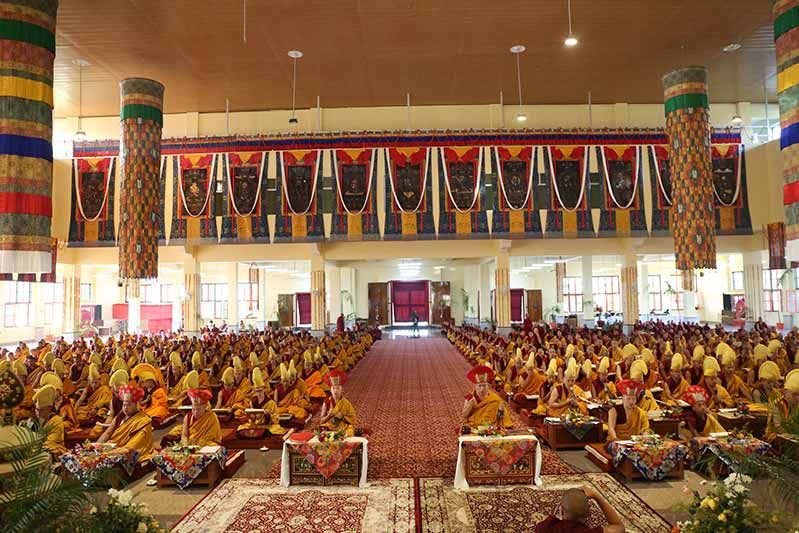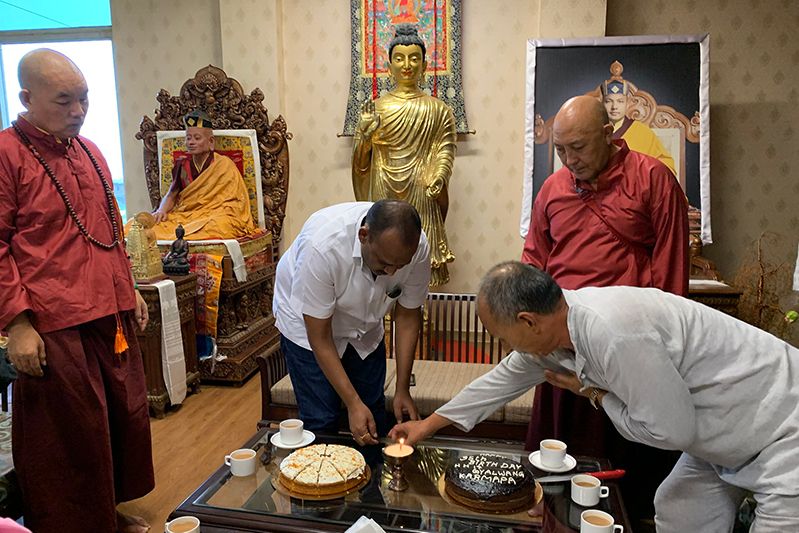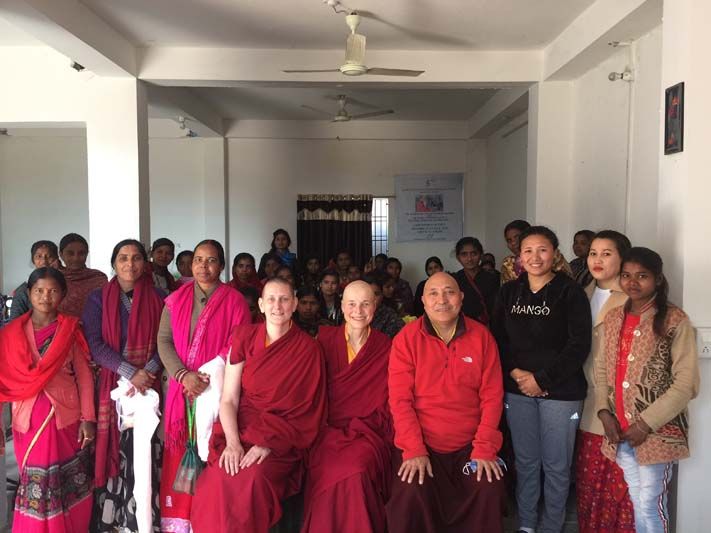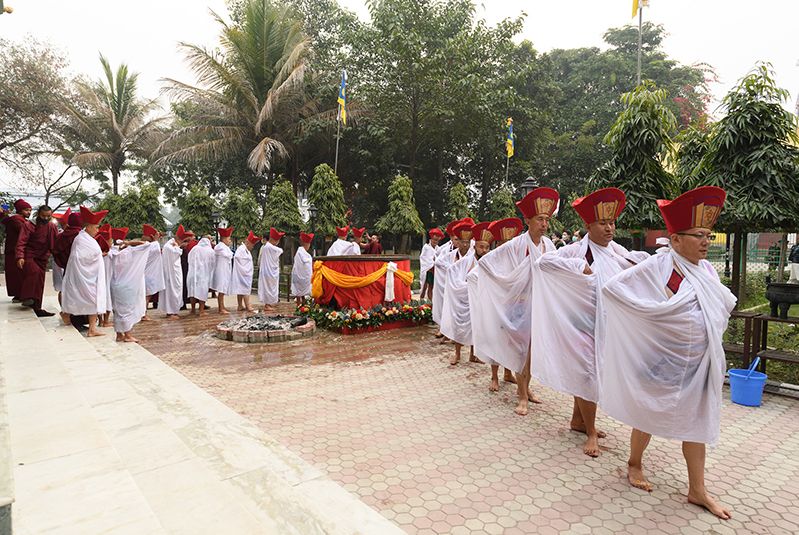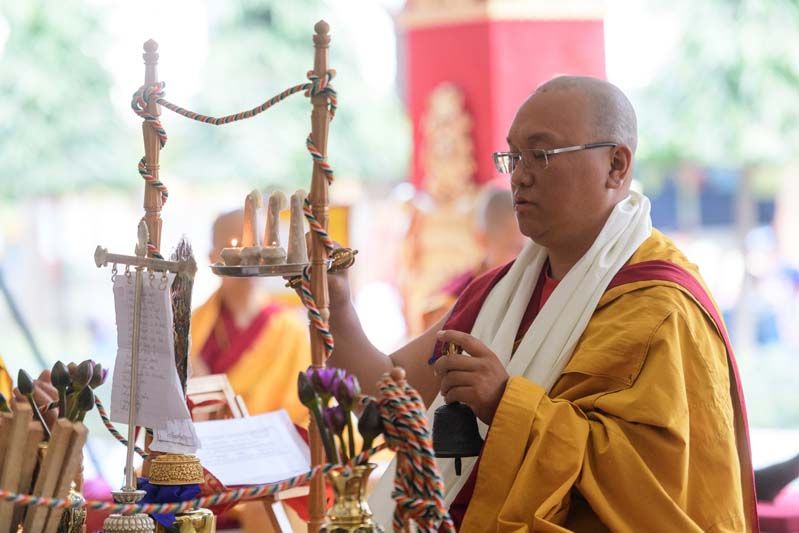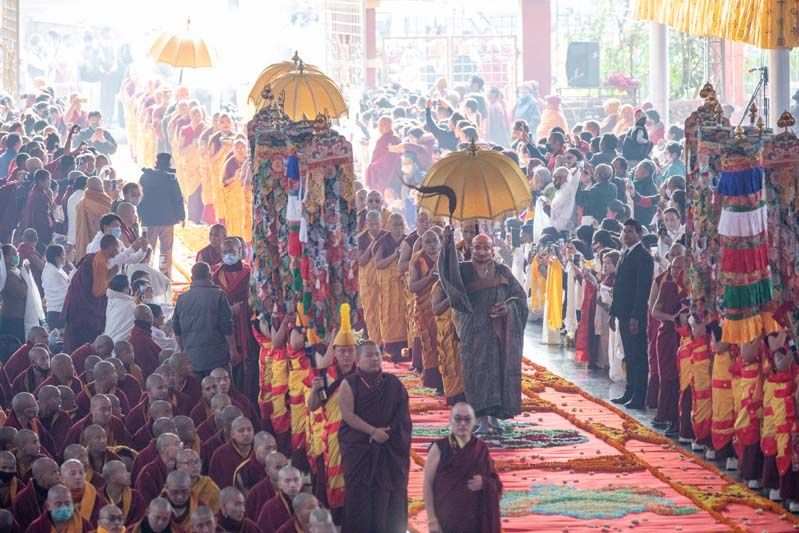Yongey Mingyur Rinpoche on the Four Foundations of Mindfulness Session 7: Actual Nature is Not Permanent, Singular, or Autonomous
- January 30, 2020
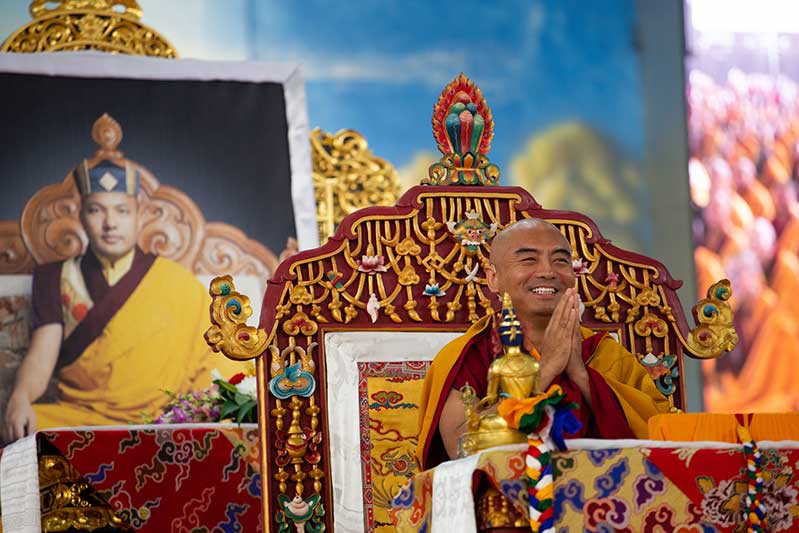
The Pavilion, Bodh Gaya, India
January 30, 2020
Rinpoche greeted everyone, “Good morning, please listen with the motivation of bodhicitta,” and explained that today was a continuation of the teachings on shamatha and insight – the preparation, main practice, and follow through.
When we talk about the four foundations of mindfulness in insight meditation, the object of our focus is body, feelings, mind, and dharmas, Rinpoche noted.
The specific characteristics of body are made out of bodies, feelings are experience, mind is clear awareness, and dharmas hold their own characteristics. We can meditate on this or we can meditate on the universal characteristics: body is impermanent by nature, feelings are suffering by nature, the mind is empty by nature, and all phenomena have the aspect of selflessness.
Summarizing from his previous sessions, he emphasized that when we meditate on all of them as being impermanent, generally, this topic is the insight common with the Foundation Vehicle.
He then asked, “How many people did their homework?” — to meditate on the scent and flavor of food while eating dinner. When eating and meditating at the same time, this is what we do during the informal meditation or the breaks. Rinpoche gave a humorous demonstration of slowly raising an invisible spoon up to his mouth and very, very slowly opening his mouth. He laughed and explained that we do not eat like this or else we would be so tight we could not swallow our food. Rather, you relax your body. You pay attention to the flavor and the scent – but not for a long time. The mind cannot stay on a single object for more than a minute when we are beginners, and that is fine.
As rain began to pound heavily outside, Rinpoche polled the attendees, “Should we begin with insight of the Mahayana or experiences we have during meditation? Raise your hand.” The raised hand responses indicated a preference to begin with experiences we have during meditation.
Rinpoche described the three stages of meditation experience as follows: at first, it is similar to water running down a steep mountain, or like the rain that is falling now; the second stage is like a river flowing through a plain; the third is like an ocean or lake that is free of waves. Rinpoche clarified, “When we get to the last stage of experience, an ocean without waves, then you are able to rest your mind one-pointedly on the object you desire.”
Rinpoche then further elaborated on each of these stages. Regarding the first stage, just as water rushes very quickly off a steep cliff and drops are sprayed everywhere, in the beginning, we have a lot of thoughts and afflictions. Everything comes into our mind. When we are meditating, we think we should be peaceful, quiet, subdued and comfortable, but the thoughts keep coming. Often, we do not realize this is a good sign, but when we are able to recognize this, it is actually very good. We assume that we lack the ability to meditate. Rinpoche used an analogy to explain: in the summer, when there is a lot of silt in the fast flowing river, we cannot see the fish, whereas in the winter when the water is clear, we can see the fish. The fish are there in the summer, but we do not see them. Similarly, the mind is enveloped in all the thoughts and afflictions, but we cannot see them. However, when we are able to direct our awareness, by the power of awareness, we can distance ourselves slightly from the thoughts and afflictions so we are not carried away by them. Then, the mind becomes a little clearer and more peaceful, just as when the water becomes clear, we can see the fish.
As you continue to practice, at a certain point, the mind becomes at ease, clear, peaceful, and vivid. And for a second or two, you may have one of three experiences: bliss, clarity, or non-conception. When you are meditating, you may be really comfortable and clear. This is what we call the experience of bliss. Or, the mind is very brilliant. Your mind might be like a sun shining in the sky with no clouds. This is called the experience of clarity. Sometimes, we have no thoughts at all. The mind is very peaceful and all appearances seem like dreams or illusions. We think, ‘What is this?’. This is called non-conception. When we have these gentle experiences, it is important not be attached to them. Generally, these experiences of bliss, clarity, and non-conception are good, but we should not cling to them as permanent or supreme.
We may have an experience of bliss, clarity, or non-conception, then a few hours later we may have the experience of dullness or agitation. We must realize that these experiences are impermanent.
Lower experiences are dullness or agitation. We know we are breathing but we do not feel like it is meditation. With dullness, we will fall asleep; and with agitation, we have really strong, coarse thoughts and afflictions. When we have too many thoughts, sometimes we question, “ Is this worse than before?” Rinpoche encouraged everyone, “When this happens, this is a really good sign. And sometimes, we have awareness, but we are not quite satisfied. Then, this is the experience of dullness. So what do we need to do?”
Rinpoche offered solutions:
We can counter either with our posture or behavior. With dullness, you can open your eyes, look up, go to a place where there is a good breeze, or walk, or meditate as you walk back and forth. Don’t eat a lot of food! When you have the experience of agitation, look down, close your eyes, wear warm clothes, eat heavy nutritious food and when you act – do things slowly and leisurely. The best thing is to use samadhi and to look at dullness or agitation itself. Let them become the support for the mind to be non-distracted.
Normally we have dullness and agitation, but we do not examine them. We need to look more closely. Whatever we look at becomes awareness. It becomes meditation.
In order to gain some experience of this, Rinpoche followed with a guided meditation on either dullness or agitation. Sitting comfortably with eyes closed, we had to scan our bodies repeatedly.
Just be aware of your body from the crown of your head to the soles of your feet and relax the muscles and ligaments in your body. Whatever feelings arise from the crown of your head to the soles of your feet, merely be aware of the feelings in your body – whether pleasant, unpleasant, or neutral – just direct your attention to them…
Whatever happens, just look at it.
We had to direct our awareness to any dullness or agitation. With feelings of dullness and agitation, when you are aware of them, they go away. Then, just rest in that. He again reminded us that when we look at thoughts there are two possibilities: they go away or they continue. Either way is fine.
Having concluded his teachings on the experiences of meditation, Rinpoche began instructions on Mahayana insight meditation which is the prajna of realizing selflessness. The object that we focus on is the thought, ‘me.’ We need to look at the nature of ego clinging. When we look at the subject and object and determine what its nature it is, we will realize prajna.
First we say, ‘This is me. This is mine.’ We cling and get attached to things saying, “This is my meditation, my phone, my momos”, and so forth. The root of this and all the afflictions comes down to the thought, ‘Me! Me!’.
If we consider the affliction of hatred, we think, ‘He did something to me’. Then, we get angry. The basis for getting angry is when it is about ‘me’. If we see someone giving us a hard time, we think, ‘He’s taking away my opportunities’. Or, if we see something attractive, we think ‘I need that’. Then, we have pride. We think, ‘I am the first person in my class or I am from a good family or I have prajna’. This is grasping at yourself as superior. This is pride.
Then, there is envy. We think things like, ‘Before my Dharma friends and I were about the same, but now they are more popular. They have more opportunities. They have a nice phone.’ There is also delusion. We think we do not know anything.
The root of all afflictions comes down to the thought of ‘me’ because we think of ‘me’ as permanent, singular and autonomous. Chuckling as he continued, Rinpoche asked:
Do you have this thought of me? Do you have it or not? We almost always have this thought of of ‘me, me’. Look at that thought of me. How do you look at that thought? When you look at the breath – in and out – then look at thought of ‘me, me,’ in a similar way.
Leading us into another guided meditation, Rinpoche instructed, “Sit up straight, but also relaxed. The mind should also rest. Look at the thought, ‘me, me’. Eyes open is fine. Eyes closed is fine.” When the mediation concluded, Rinpoche asked, “When you look at the thought of ‘me’, do you find it or not?” Rinpoche then polled everyone asking those who found ‘me’ to raise their hands and then those who did not to raise their hands. He then joked, “You’ve realized selflessness, right?”
The moment we look for ‘me’ we often cannot find it, so then we rest in that. If you are able to find the thought of ‘me’, that is excellent. He gave some examples: If you fall in a river, you do not see the water flowing quickly. When you are watching a movie, you are outside the movie. When you see the thought of ‘me’, then you are not being controlled by it. But, this is temporary – only an instant or two and then we go back into ego-clinging. Generally, this thought of ‘me’ is everywhere.
Where is the ‘me’? Is it around the heart, the head? Everyone has a different feeling. But, if you look at it, you cannot find it. If you do find it, you rest in the finding. At the beginning of insight meditation, we start with resting meditation, then we move on to analytical meditation. Insight meditation is primarily analysis, investigating with mindfulness and awareness. That awareness is shamatha and analysis is insight. Shamata and insight are in union. There is no insight without shamatha. When we consider this is impermanent, we are giving a particular job to our minds and making them work. When we analyze impermanence, that is the insight of the Foundation Vehicle. Then, we have to find the ‘me’ and the way we grasp at it as singular and permanent.
Rinpoche then posed, three questions: 1) Did you eat food yesterday? 2) Where is Mingyur Tulku sitting right now? 3) Are you singular or are you many when you are listening to the instructions?
In response to the first question, Rinpoche explained that if you answered, “Yes,” to the first question, this is clinging to permanence. The reason is, “Yesterday’s me is not here right now.” In our minds, we think, ‘I am eating or I ate’. This is clinging to the thought of ‘me’. We are not always aware of everything changing because we cling to a continuum of singularity and grasp that as being autonomous and permanent. To give an example: Can cross the same river twice? You cannot, because the water is flowing and every step you take you are going into a new river.
In response to the second question, Rinpoche clarified the response by asking for another person’s name. “Karma Tsangpo. Karma Tsangpo has a head, arms, and legs. When we think, ‘my body, my mind – the me,’ we think it is something other than the five aggregates. It is autonomous, single. It is alone and in control of itself.”
Regarding the final and third question, Rinpoche noted that, “We think we are one. We cling to singularity.” When we cling to the ‘me’, it is because we think of it as permanent, singular, and autonomous.
Rinpoche humorously honed his point on impermanence and selflessness with a vivid demonstration. He covered his face and only extended his arm out of his golden chögu and asked, “Is this arm Mingyur Tulku?” As if playing a game of hide and seek, his head popped out as he re-situated the robe and then only stuck out his thumb. “Is this finger Mingyur Tulku?” If the arm is Mingyur Tulku and the thumb is Mingyur Tulku, then there are many! They are all parts so there is no single Mingyur Tulku. The head, the arms, the fingers are not me. If we look, we do not find a singular self. We only project a singular self mentally. When we look at the actual nature, it is not permanent, singular, or autonomous.
To conclude the morning session, Rinpoche led everyone through an analytic meditation examining the thought of ‘me.’
We grasp at ourselves as autonomous. We grasp at an independent me. Look at that thought. We think we are singular, but we are many different parts aggregated together. Look and see it as it is…when our conceptual mind grasps, this is ego clinging. We get happy or sad in a moment as we wander through samsara.
As the session ended, Rinpoche instructed everyone to continue with this awareness of the thought of ‘me’ throughout the tea-break.
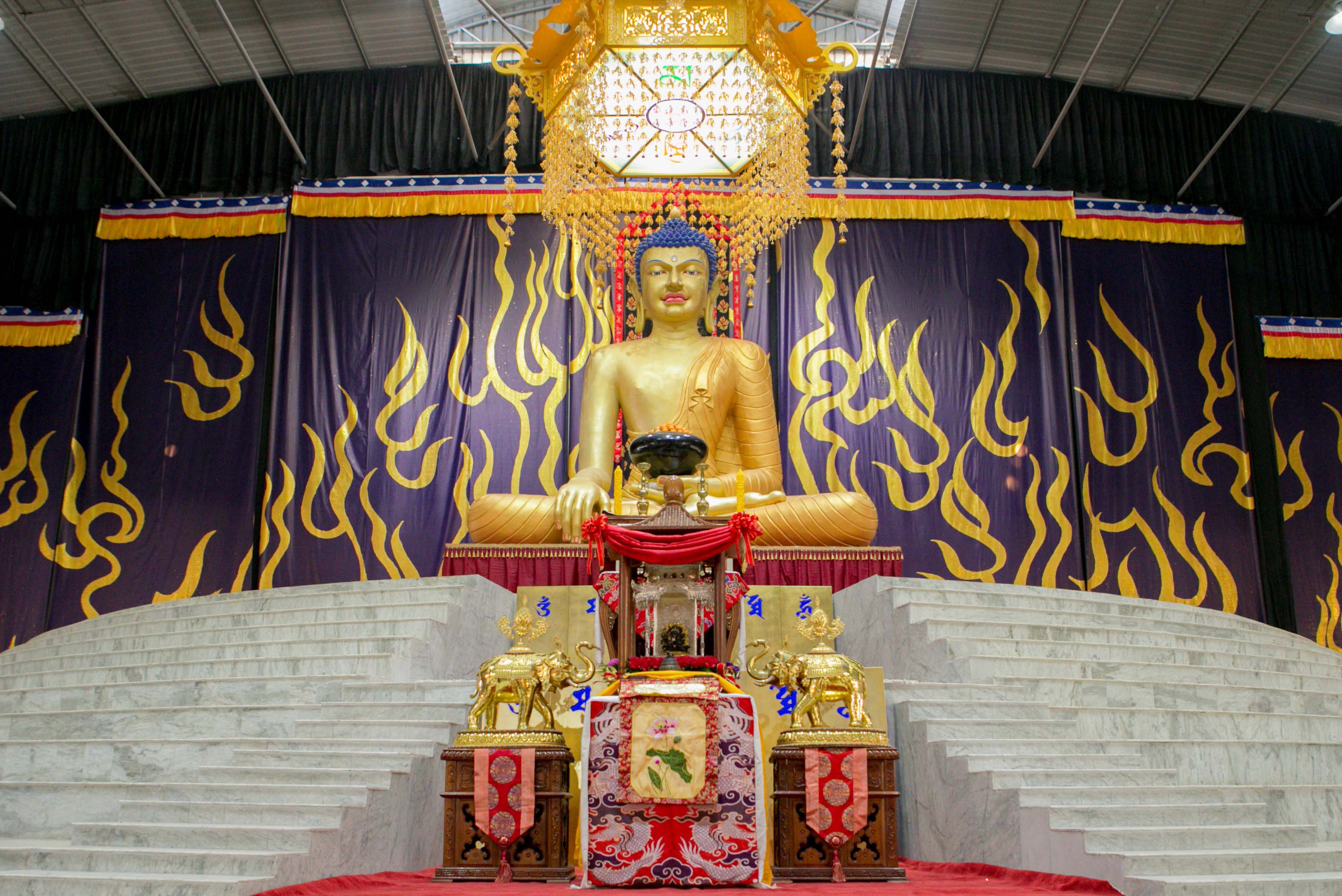
37th Kagyu Monlam Schedule
Tibetan / English / Chinese • French • German • Indonesian • Korean • Polish • Russian • Spanish • Vietnamese
Dharma Teachings
 Meditation Instructions
Meditation Instructions
Recorded during the 37th Kagyu Monlam, Bodhgaya, India. January 28-30, 2020.

